Blood as food
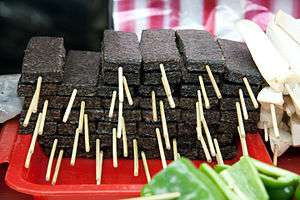
Many cultures consume blood as food, often in combination with meat. The blood may be in the form of blood sausage, as a thickener for sauces, a cured salted form for times of food scarcity, or in a blood soup.[1] This is a product from domesticated animals, obtained at a place and time where the blood can run into a container and be swiftly consumed or processed. In many cultures, the animal is slaughtered. In some cultures, blood is a taboo food.
Methods of preparation
Sausage
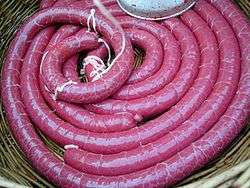
Blood sausage, or black pudding, is any sausage made by cooking animal blood with a filler until it is thick enough to congeal when cooled. Pig or cattle blood is most often used. Typical fillers include meat, fat, suet, bread, rice, barley and oatmeal. Varieties include drisheen, moronga, black pudding, blutwurst, blood tongue, kishka (kaszanka), biroldo, morcilla, mustamakkara, verivorst, and many types of boudin.
Pancakes

Blood pancakes are encountered in Galicia (filloas), Scandinavia, and the Baltic; for example, Swedish blodplättar, Finnish veriohukainen, and Estonian veripannkoogid.
Soups, stews and sauces
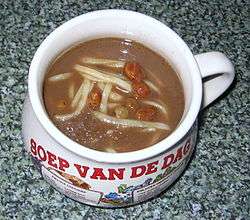
Blood soups and stews, which use blood as part of the broth, include czernina, dinuguan, haejangguk, mykyrokka, pig's organ soup, tiet canh and svartsoppa.
Blood is also used as a thickener in sauces, such as coq au vin or pressed duck, and puddings, such as tiết canh. It can provide flavor or color for meat, as in cabidela.
Solidified
Blood can also be used as a solid ingredient, either by allowing it to congeal before use, or by cooking it to accelerate the process. In Hungary when a pig is slaughtered in the morning, the blood is fried with onions and served for breakfast. In China, "blood tofu" (Chinese: 血豆腐; pinyin: xiě dòufǔ) is most often made with pig's or duck's blood, although chicken's or cow's blood may also be used. The blood is allowed to congeal and simply cut into rectangular pieces and cooked. This dish is also known in Java as saren, made with chicken's or pig's blood. Blood tofu is found in curry mee as well as the Sichuan dish, maoxuewang. In Tibet, congealed yak's blood is a traditional food.[2]
Raw
In some cases, blood is used as an ingredient without any additional preparation. Raw blood is not commonly consumed by itself, but may be used as an addition to drinks or other dishes. One example is the drinking of seal blood which is traditionally believed by the Inuit to bring health benefits.[3]
Religious consumption of blood
The Catholic Church, as well as the Eastern Orthodox, Oriental Orthodox, Lutheran, and some Anglican churches, believe that in the sacrament of the Eucharist, the participants consume the literal blood and body of Jesus Christ. The post-communion prayer of the 1662 Anglican Book of Common Prayer describes the meal as "spiritual food". Many other Christian denominations symbolically consume the Eucharist.
However, nowhere in Christianity is the drink consumed at the Eucharist actual blood, even among denominations believing in transsubstantiation (the literal transformation of the bread and wine into the Body and Blood). The consumption of actual blood is in fact forbidden according to the book of Leviticus, part of both Jewish and Christian holy scriptures. The "words of institution", which includes the words Jesus said to his Disciples at the Last Supper, would have been surprising and even unsettling to those present for this reason, especially as the Last Supper was a Passover seder. The ban on consumption of blood by Christians was affirmed after Jesus' death by the Apostolic Decree, chronicled in the Acts of the Apostles.
Other religions and spiritual traditions do consume actual blood as part of rituals. Some Pagan traditions, Satanism, a few Native American and voodoo traditions are reported to consume actual blood, in some cases human (usually willingly donated by participants in the ceremony). The symbolism of the blood itself and the act of drinking it varies between these traditions; in Pagan tradition, the blood of many participants is mingled in a chalice which they then drink from, symbolizing a bond between them not unlike becoming blood brothers. In voodoo, blood from various sources, including chicken's blood, goat's blood and even menstrual blood is a common ingredient in spells and potions. Satanism, similar to voodoo, is a nebulous collection of traditions, generally associated with devil worship and perversions of images from Gothic Romanticism, including vampiric acts such as the drinking of blood. These were originally invented by Gothic writers as violations of Christian doctrine intended to invoke disgust and horror in the reader.
Cultural considerations
Some cultures consider blood to be a taboo form of food. In Abrahamic religions, Jewish and Muslim cultures forbid the consumption of blood. In the New Testament, blood was forbidden by the Apostolic Decree (Acts 15:19-21) and is still forbidden among Greek Orthodox.[4] See also Biblical law in Christianity and Communion (Christian).
The Igbo ethnic group of Nigeria has no explicit prohibitions against eating blood, but most regard it with disgust and refuse to eat any meat perceived as "bloody" or undercooked (such as raw meat in sushi or steak prepared raw, rare, or medium). Goats, cattle, and other animals slaughtered in the traditional Igbo manner are dispatched with a single cut across the neck and then most or all of the blood is allowed to slowly drain from the wound. This practice may have been influenced by the Igbo Jewish community that apparently predates contact with Europe. Many Igbos who buy butchered, packaged meat from groceries and supermarkets are in the habit of washing the blood from the meat with water before preparing it.
Dishes
Africa
Among the Maasai people, drinking blood from cattle is a part of the traditional diet, especially after special occasions such as ritual circumcision or the birth of a child.[5]
Asia
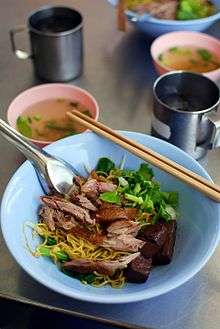
In China and some regions of Southeast Asia, coagulated chicken, duck, goose or pig blood, known in Chinese as "blood tofu" (血豆腐 xuě dòufǔ) is used in soups, such as the classic Thai dish Tom Lued Moo (pork blood soup). Thailand also has a dish known as Nam Tok, which is a spicy soup stock enriched with raw cow or pig's blood. It is often used to enrich regular noodle dishes, as well as in Khao soi.[6] In Taiwan, pig's blood cake (Chinese: 豬血糕; pinyin: zhū xiě gāo) is made of pork blood and sticky rice. It is fried or steamed as a snack or cooked in a hot pot.
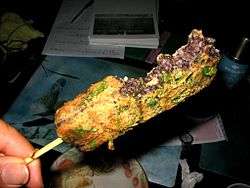
In Korea, people consume Seonjiguk, a soup with coagulated blood and Sundae, a blood sausage made generally by boiling or steaming cow or pig's intestines that are stuffed with various ingredients, such as pig's blood, cellophane noodles, kimchi, scallions, etc.
In the Philippines, a popular dish called dinuguan is made from pig's blood and seasoned with chili and is traditionally eaten with steamed rice. The northern tradition calls for stir frying both the seasoned blood and chosen meat with vinegar until dry. This is known as "dinardaraan" in the north but also known as "crispy dinuguan" in other areas.
In Laos and Northeast Thailand), a raw version of laap, a meat salad, is made with minced raw meat, seasoned in spices, and covered with blood. The spicy noodle soup Nam ngiao and certain variants of Khao soi of the cuisine of Shan State and Northern Thailand contain diced curdled blood.[6][7]
In the South Indian state of Tamil Nadu, stir-fried lamb blood is a common dish had for breakfast and lunch. When prepared alone it is called raththam poriyal. More commonly it is stir-fried with lamb stomach and intestines with spices like ginger, garlic, cloves, cinnamon, red chili powder, green chilies, coriander powder, cumin, shallots and grated coconut. This dish is very common in the Madurai and Kongu Nadu region of Tamil Nadu.
In Indonesia, especially the Batak tribe in North Sumatera, pig's blood is used as an ingredient and sauce mixed with andaliman (Zanthoxylum acantophodium) for a cuisine named Sangsang (read saksang).
In Vietnam, congealed pork blood is used in Bun bo Hue (a spicy noodle soup), as well as congee (a type of rice porridge). It is simply solidified, then put into the broth to absorb the flavor.
In China and Vietnam certain types of snake blood are considered to be an aphrodisiac, and are drunk with rice wine.
Europe
In Britain, Ireland, and some Commonwealth countries, "black pudding" or "blood pudding" is made from blood and some filler grains and spices, often oatmeal. Blood sausage is also popular in Norway (Blodpølse), Sweden (blodkorv), Finland (mustamakkara) and Baltic states Latvia (asinsdesa) and Estonia (verivorst), as well as in Poland (kaszanka), Germany (blutwurst), Austria (blunzen), Hungary (véres hurka), Spain (morcilla, botifarra), Croatia (krvavica), Slovakia (krvavnička), Romania (sângerete), Slovenia (krvavica), Ukraine (krovyanka) and France (boudin).
In Ireland, there is ample evidence of the persistence of the practice of bleeding live cattle until well into the 19th century. It was considered to be a preventative measure against cattle diseases, and the blood drawn, when mixed with butter, herbs, oats or meal, provided a nutritious emergency food.[8]
In Sweden, the blood soup svartsoppa, made with goose blood, is traditionally eaten on the eve of Saint Martin, especially in the southern region of Skåne. Other popular dishes, with blood as one of the ingredients include blodpudding (black pudding], blodplättar (blood pancakes), blodpalt (potato dumplings flavoured with reindeer or pig blood) and paltbröd (bread with blood in it, which is dried and boiled and eaten together with fried pork and bèchamel or onion sauce).
In Finland, pig's blood is used, with milk, flour and molasses, to make blood pancakes veriohukainen, usually served with lingonberry jam.[9]
In Northern Germany pig's blood used to be traditionally mixed with vinegar, scraps, spices and sugar to make schwarzsauer. It's eaten warm or preserved in jars. Changes in taste and lifestyle have made this an uncommon dish.[10]
In Portugal, the northern region known as Minho has a traditional blood soup named papas de sarrabulho. "Papas" translates as "mash" and "sarrabulho" is a popular expression for coagulated blood, so the literal translation would be "mashed blood". The soup is made with pig's blood, chicken meat, pork, ham, salami, lemon and bread, and is typically sprinkled with cumin, which provides the dish with its distinctive odor. It is usually served in the winter because it is a rather heavy dish. The dish is seldom eaten in Southern Portugal. Also very popular, is morcela sausage, a type of black pudding. Another traditional Portuguese dish known as cabidela is also made by cooking chicken or rabbit in its own blood, sometimes diluted with vinegar.
In Spain, the morcilla sausage is a kind of black pudding mainly made with pig blood, with spices, fat, and sometimes vegetables. In Andalusia sangre encebollada and Valencian sang amb ceba are popular dishes made with chicken or pork solidified blood and onion.[11]
In ancient Lakedaimon, the Greek city-state of Sparta, the black broth was common: a soup with pork meat and blood.
Mexico and South America
As in Europe, several varieties of blood sausage are also popular in Mexico (moronga), Peru (relleno), Chile (ñache), Argentina, Uruguay, and Puerto Rico (morcilla). In the western region of Santander Colombia, a dish called pepitoria is made from rice cooked in goat blood. Mexicans from certain regions eat goat's stomach stuffed with pork blood and vegetables as a delicacy. In Brazil, the traditional Portuguese dish known as cabidela (see above) is also eaten. Yaguarlocro in Ecuador is a potato soup made with sprinklings of goat's blood.
References
- ↑ Davidson, Alan. The Oxford Companion to Food. 2nd ed. UK: Oxford University Press, 2006., p. 81-82.
- ↑ Ma Jian, Stick Out Your Tongue Chatto and Windus London, 2006.
- ↑ Borré, Kristen. "Seal Blood, Inuit Blood, and Diet: A Biocultural Model of Physiology and Cultural Identity." Medical Anthropology Quarterly 5 (1991): 48–62.
- ↑ Karl Josef von Hefele's commentary on canon II of Gangra "NPNF2-14. The Seven Ecumenical Councils". Retrieved 11 October 2010. notes: "We further see that, at the time of the Synod of Gangra, the rule of the Apostolic Synod with regard to blood and things strangled was still in force. With the Greeks, indeed, it continued always in force as their Euchologies still show. Balsamon also, the well-known commentator on the canons of the Middle Ages, in his commentary on the sixty-third Apostolic Canon, expressly blames the Latins because they had ceased to observe this command. What the Latin Church, however, thought on this subject about the year 400, is shown by St. Augustine in his work Contra Faustum, where he states that the Apostles had given this command in order to unite the heathens and Jews in the one ark of Noah; but that then, when the barrier between Jewish and heathen converts had fallen, this command concerning things strangled and blood had lost its meaning, and was only observed by few. But still, as late as the eighth century, Pope Gregory the Third (731) forbade the eating of blood or things strangled under threat of a penance of forty days. No one will pretend that the disciplinary enactments of any council, even though it be one of the undisputed Ecumenical Synods, can be of greater and more unchanging force than the decree of that first council, held by the Holy Apostles at Jerusalem, and the fact that its decree has been obsolete for centuries in the West is proof that even ecumenical canons may be of only temporary utility and may be repealed by disuse, like other laws."
- ↑ Craats, Rennay (2005). Maasai. Weigl Publishers. p. 25. ISBN 978-1-59036-255-6.
- 1 2 Khao Soy Tai or Shan Kao Soi by Sao Tern Moeng
- ↑ Cooking Northern Thai Food – Khanom Jeen Nam Ngeow
- ↑ A. T. Lucas, Cattle In Ancient Ireland, pp. 200 -217, Boethius Press, 1989, ISBN 0-86314-145-5
- ↑ "Glossary of Finnish dishes". Retrieved 11 October 2010.
- ↑ de:Schwarzsauer
- ↑ "Archived copy". Archived from the original on 2012-02-03. Retrieved 2011-12-10.
External links
| Wikimedia Commons has media related to Blood-based food. |